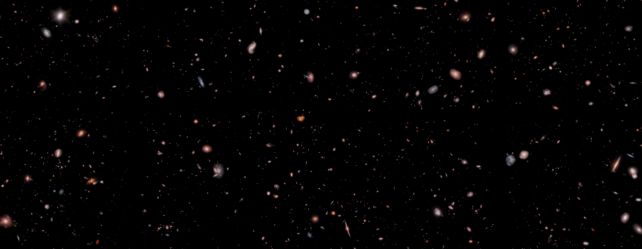A red blob lurking in the background of a deep image of space has now been validated as one of the earliest galaxies known in the Universe.
It's called Maisie's Galaxy, and spectroscopic analysis has confirmed the James Webb Space Telescope observed the object as it appeared just 390 million years after the Big Bang. That's not quite as early as scientists initially thought, but it is now officially one of the earliest confirmed galaxies in the Universe.
According to a team led by astronomer Pablo Arrabal Haro of the US National Science Foundation's NOIRLab, the results not only help confirm the early Universe is indeed way more populated than we expected, but that care is needed in analyzing the JWST observations.
"The exciting thing about Maisie's galaxy is that it was one of the first distant galaxies identified by JWST, and of that set, it's the first to actually be spectroscopically confirmed," says astronomer Steven Finkelstein of the University of Texas at Austin, who named the galaxy in honor of his daughter, on whose birthday the galaxy was discovered last year.
Identifying the timeframe of galaxies emerging in the early Universe takes a bit of figuring out.
The best tool we currently have is redshift. Because the Universe is expanding at an accelerating rate, most objects far outside of our galaxy appear to be receding. The farther light has had to travel to reach us, the faster distant material seems to be moving away from us.
This results in the light becoming stretched, or redshifted; its wavelengths become longer, attenuating out into the redder parts of the spectrum. Using the letter z to describe this phenomenon, astronomers use measures of redshift to work out the time the light was emitted.
JWST is a powerful instrument that studies the Universe in these infrared wavelength. This is why scientists are using it to look deeper into the early Universe than we've ever been able to before.
But there is more than one way to calculate z. When Finkelstein and his team first published on Maisie's Galaxy, they based their redshift estimate on photometry; that is, the brightness of the light seen through several filters. That work returned an estimate of z~12. That means they thought the galaxy was observed around 366 million years after the Big Bang.
To refine that result, the team followed up using the JWST's spectroscopic instrument, NIRSpec, which splits the light into different near-infrared wavelengths for a more detailed analysis. And the NIRSpec data returned a redshift of z=11.4; around 390 million years after the Big Bang. This means that the light from Maisie's Galaxy traveled for around 13.4 billion years before being picked up by JWST.
The research also looked at two other early Universe galaxies picked up in the Cosmic Evolution Early Release Science (CEERS) Survey that gave us Maisie's Galaxy. One of those returned a redshift consistent with its photometric estimate, with a redshift of z=11.043; but the other was quite off.

CEERS-93316 was tentatively identified at 250 million years after the Big Bang – redshift z≃16.4 – but spectroscopic follow-up was needed to confirm. And spectroscopic follow-up got a very different redshift, just z=4.9. That's around 1.2 billion years after the Big Bang.
The misidentification occurred because it had three overlapping properties that mimicked the colors expected of a galaxy spotted at z≈16 in photometric analysis.
Other galaxies could also fall into this "triple overlap zone", the researchers say, requiring extra care for those objects that appear to have particularly high redshifts.
But, all's well that ends well, as far as CEER-93316 is concerned.
"It would have been really challenging to explain how the Universe could create such a massive galaxy so soon," Finkelstein says.
"So, I think this was probably always the most likely outcome, because it was so extreme, so bright, at such an apparent high redshift."
The research has been published in Nature.
